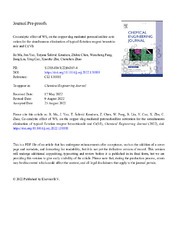Приказ основних података о документу
Co-catalytic effect of WS2 on the copper slag mediated peroxodisulfate activation for the simultaneous elimination of typical flotation reagent benzotriazole and Cr(VI)
| dc.creator | Ma, Bo | |
| dc.creator | Yao, Jun | |
| dc.creator | Šolević Knudsen, Tatjana | |
| dc.creator | Chen, Zhihui | |
| dc.creator | Pang, Wancheng | |
| dc.creator | Liu, Bang | |
| dc.creator | Cao, Ying | |
| dc.creator | Zhu, Xiaozhe | |
| dc.creator | Zhao, Chenchen | |
| dc.date.accessioned | 2023-01-09T18:27:58Z | |
| dc.date.available | 2023-08-29 | |
| dc.date.issued | 2023 | |
| dc.identifier.issn | 1385-8947 | |
| dc.identifier.uri | https://cer.ihtm.bg.ac.rs/handle/123456789/5547 | |
| dc.description.abstract | In this study, efficient simultaneous elimination of typical mine pollutants benzotriazole (BTA) and Cr(VI) was achieved by using a copper slag (CS) activated peroxodisulfate (PDS) Fenton system, with WS2 as a co-catalyst. The combined use of these two mine-sourced materials enables excellent pollution removal efficiency. CS can continuously release ferrous ions for the advanced oxidation processes (AOPs), while WS2 as a co-catalyst has key roles in acceleration of the rate-limiting step of Fe3+/Fe2+ conversion and prevention of Fe3+ precipitation. In this process, Fe3+/Fe2+ conversion primarily occurs on the surface of WS2, whereas PDS decomposition and BTA degradation are dominated by homogeneous Fenton reactions. Dissolved Fe2+ has a main role in the activation of PDS and generation of ROS. The contributions of free radicals, singlet oxygen and Fe(IV) in BTA degradation were carefully evaluated. Fe(IV) was identified as the major ROS responsible for degradation of BTA in the CS/WS2/PDS system. This was further confirmed by the Raman spectra and the detection of BTA degradation products formed by the transfer of oxygen atoms. Kinetics calculation showed that Fe(IV) was responsible for 63.4 % of the degradation of BTA. More importantly, water matrix had a low impact on the degradation of BTA due to the high selectivity of Fe(IV). This study provides a new strategy for a cost-effective and efficient decontamination of the environment in mining areas. | sr |
| dc.language.iso | en | sr |
| dc.publisher | Elsevier | sr |
| dc.relation | Major National R & D Projects for Chinese Ministry of Science and Technology (2019YFC1803500) | sr |
| dc.relation | National Natural Science Foundation of China (41720104007) | sr |
| dc.relation | China University of Geosciences, Beijing (ZD2021YC027) | sr |
| dc.relation | China University of Geosciences, Beijing ( ZD2021YC045 ) | sr |
| dc.relation | info:eu-repo/grantAgreement/MESTD/inst-2020/200026/RS// | sr |
| dc.relation | Higher Education Discipline Innovation Project ( B21017 ) | sr |
| dc.relation.isversionof | https://cer.ihtm.bg.ac.rs/handle/123456789/5369 | |
| dc.relation.isversionof | https://doi.org/10.1016/j.cej.2022.138888 | |
| dc.rights | embargoedAccess | sr |
| dc.rights.uri | https://creativecommons.org/licenses/by-nc-nd/4.0/ | |
| dc.source | Chemical Engineering Journal | sr |
| dc.subject | Combined pollution | sr |
| dc.subject | Copper slag | sr |
| dc.subject | Ferryl | sr |
| dc.subject | Iron redox cycle | sr |
| dc.subject | Kinetics | sr |
| dc.subject | Metal sulfide | sr |
| dc.title | Co-catalytic effect of WS2 on the copper slag mediated peroxodisulfate activation for the simultaneous elimination of typical flotation reagent benzotriazole and Cr(VI) | sr |
| dc.type | article | sr |
| dc.rights.license | BY-NC-ND | sr |
| dc.citation.volume | 451 | |
| dc.citation.issue | 3 | |
| dc.citation.spage | 138888 | |
| dc.citation.rank | aM21~ | |
| dc.description.other | This is the peer-reviewed version of the article: B. Ma, J. Yao, T. Šolević Knudsen, Z. Chen, W. Pang, B. Liu, Y. Cao, X. Zhu, C. Zhao, Co-catalytic effect of WS2 on the copper slag mediated peroxodisulfate activation for the simultaneous elimination of typical flotation reagent benzotriazole and Cr(VI), Chemical Engineering Journal (2022) 451, 3, 138888, doi: [https://doi.org/10.1016/j.cej.2022.138888] | |
| dc.description.other | Published version: [https://cer.ihtm.bg.ac.rs/handle/123456789/5369] | |
| dc.identifier.doi | 10.1016/j.cej.2022.138888 | |
| dc.identifier.fulltext | http://cer.ihtm.bg.ac.rs/bitstream/id/23366/1-s2.0-S1385894722043674-main.pdf | |
| dc.identifier.scopus | 2-s2.0-85137290343 | |
| dc.type.version | acceptedVersion | sr |


